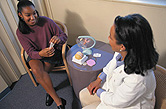Many with condition are afraid exercise will make the condition worse
WEDNESDAY, Jan. 14, 2015 (HealthDay News) — Easing fears that exercise may worsen symptoms of chronic fatigue syndrome is crucial in efforts to prevent disability in people with the condition, according to research published online Jan. 13 in The Lancet Psychiatry.
A previous study found that people with chronic fatigue syndrome benefit from two types of counseling: cognitive behavioral therapy (CBT), or graded exercise therapy, a personalized and gradually increasing exercise program. This new study looked at how the two approaches can help patients. Trudie Chalder, Ph.D., a professor of cognitive behavioral psychotherapy at King’s College London, and colleagues found that the most important factor was easing patients’ fears that increased exercise or activity will make their symptoms worse. This accounted for up to 60 percent of the therapies’ overall effect on patient outcomes. Exercise therapy reduced such fears more than CBT, the researchers said.
“Our results suggest that fearful beliefs can be changed by directly challenging such beliefs (as in CBT) or by simple behavior change with a graded approach to the avoided activity (as in graded exercise therapy),” Chalder said in a journal news release. “Clinically, the results suggest that therapists delivering CBT could encourage more physical activities such as walking, which might enhance the effect of CBT and could be more acceptable to patients,” she added.
Other experts came to a somewhat different conclusion. “We assume that an increase in physical activity is nothing more than a catalyst for the change in cognitions about activity and symptoms in patients with chronic fatigue syndrome,” Hans Knoop, M.D., and Jan Wiborg, of the Radboud University Nijmegen Medical Center in the Netherlands, write in an accompanying editorial. “Future studies should focus on how these beliefs can be changed more rapidly and effectively. In our own protocol, we ask patients to gradually increase physical activity and present it as a way to increase your ability to become active,” they added. “Once a patient is convinced that this is possible, irrespective of the actual level of activity, an important step towards recovery is taken.”
Copyright © 2015 HealthDay. All rights reserved.








